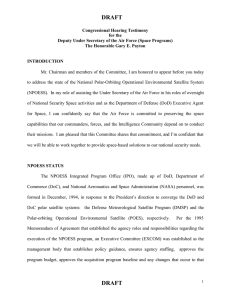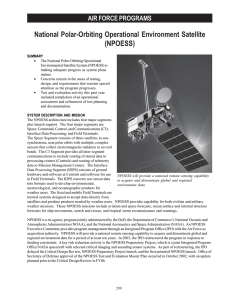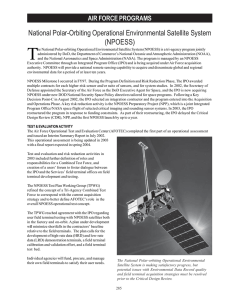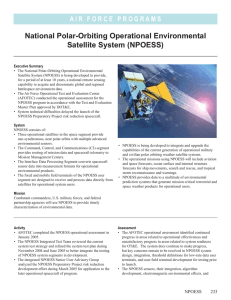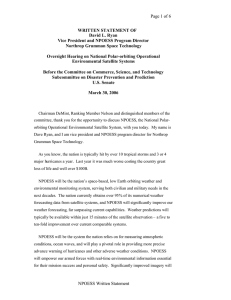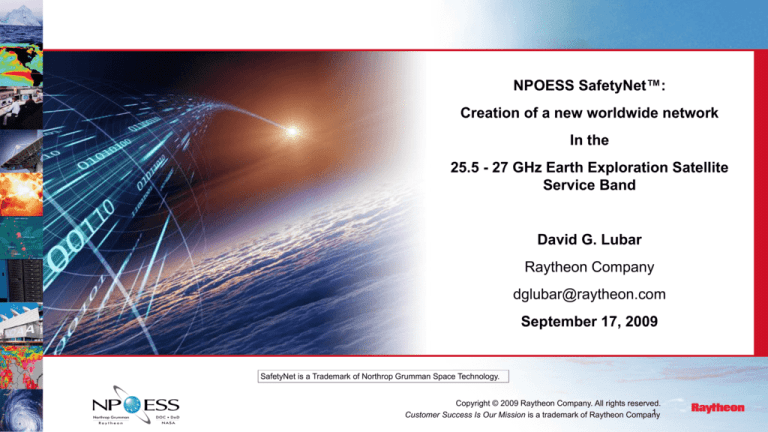
NPOESS SafetyNet™:
Creation of a new worldwide network
In the
25.5 - 27 GHz Earth Exploration Satellite
Service Band
David G. Lubar
Raytheon Company
dglubar@raytheon.com
September 17, 2009
SafetyNet is a Trademark of Northrop Grumman Space Technology.
Copyright © 2009 Raytheon Company. All rights reserved.
1
Customer Success Is Our Mission is a trademark of Raytheon Company
.
Earth and Space Observation
• Earth and Space observations providing the U.S. and the
international community with fast, accurate global
environmental data is the primary mission of NPOESS
– Improving weather forecasts and warnings
– Benefiting society with diverse applications
– Increasing recognition of long-term climate changes
• NPOESS will help provide the major satellite-based
components of the Global Earth Observation System of
Systems (GEOSS)
– GEOSS is a large international cooperative effort bringing
together valuable ground and space environmental data to
benefit mankind
– 76 government members and 56 intergovernmental organizations
2
National Polar-orbiting Operational Environmental
Satellite System (NPOESS) Background
• The National Polar-orbiting Operational Environmental Satellite
System (NPOESS) will greatly improve the frequency,
resolution and accuracy of observations
– Decreased data product latency
• NPOESS latencies will be <30 minutes
• Current polar systems have latencies of two to
three hours
– Increased volume of data products delivered
to users
• 100X more data will be provided to the national
weather centers and the national environmental
data archive
– Improved products based on improved sensors
and better scientific algorithms
Equatorial Crossing
Local Times
• Giving scientists more confidence in the weather and
environmental results that are produced
NPOESS benefits national and international cooperation
3
NPOESS Spacecraft
• NPOESS will carry six primary sensors
–
–
–
–
–
–
Visible/Infrared Imager/Radiometer Suite (VIIRS)
Cross-track Infrared Sounder (CrIS)
Advanced Technology Microwave Sounder (ATMS)
Microwave Imager/Sounder (MIS)
Ozone Mapping and Profiler Suite (OMPS)
Space Environment Monitor (SEM)
• They will provide data to the NPOESS ground processing
system that will produce nearly 40 different Environmental
Data Products (EDRs)
4
NPOESS Concept of Operations
•Fully integrated to
meet driving data
latency requirements
•Flexible, scalable,
modular architecture
throughout
•Extensive Command
Control and
Communications
heritage from proven
operational programs
•Enterprise
Management ensures
high system
availability
•Dual use of software
for IDPS and FTS
reduces cost and risk
•Full data processing
capability at each
central
5
NPOESS SafetyNet™
6
SafetyNet™ Architecture
•Globally distributed ground receptors
(16 receptors in 15 locations) achieve
NPOESS data latency requirements
–Receptors located at physically secure
fiber network entry points
–Receive mission data automatically per
MMC contact schedules
Blank
• Data routed from receptors to Centrals
–Cost-effective secure Virtual Private Networks
(VPNs) between NPOESS facilities
–Supplemented by satellite communications for
Antarctic region
Network Router
Firewall
Network Router
Firewall
GPS Time Ref Unit
Ground Station
Computer
Display/Keyboard
Multirate
Wideband
Data Receiver
Avtec
PTP - EX
Power Panel
7
NPOESS SafetyNet™ Ground Network
• 15 locations,
10 countries
• Full motion to
track polar
satellite
• Ka-Band
frequency
• Receive-only
• Autonomous
operations
Worldwide Fiber Optics communications make rapid delivery of NPOESS data possible
SafetyNet is a Trademark of Northrop Grumman Space Technology.
8
• Receptors at
fiber entry
points with
timely data
delivery
• Leverages high
bandwidth
commercial
fiber, cost
effective
delivery
SafetyNet™ Locations around the Globe
•
•
•
•
•
•
Antarctica
Australia
Brazil
Chile
India
Japan
•
•
•
•
•
New Zealand
Norway (Svalbard)
Spain
South Africa
USA – 5 sites
9
WORLDWIDE SPECTRUM CONSIDERATIONS IN THE EESS BAND:
FREQUENCY ALLOCATION TABLES 25.5 – 27 GHZ
10
Australia
•
Australia has authorized this band for auction, in support of terrestrial services, under
spectrum licensing regime
Column 1: ITU Radio Regulations Table of
Allocations
Region 1
25.5 – 27
Region 2
EARTH EXPLORATION-SATELLITE
(space-to-Earth) 536B
FIXED
MOBILE
SPACE RESEARCH (space-to-Earth)
536C
Standard frequency and time signalsatellite (Earth-to-space)
536A
Column 2:
Australian Table of Allocations
Region 3
25.5 – 27
EARTH EXPLORATION-SATELLITE
(space-to-Earth)
FIXED
INTER-SATELLITE 536
MOBILE
SPACE RESEARCH (space-to-Earth)
Standard frequency and time signalsatellite (Earth-to-space)
536A AUS 87
http://www.acma.gov.au/WEB/STANDARD/pc=PC_2713
11
Australian Spectrum
•
•
•
•
Australia has subdivided the country into market
areas for terrestrial use of the 26.5-27.5 GHz band
Spectrum in part of this band failed to sell at an
auction held in 2000
Frequencies authorized for auction are authorized
for Spectrum Licenses under Australian
regulations
Otherwise Apparatus licenses are issued to
license holders either a) outside of bands
designated for auction or b) with special
circumstances approval for those within bands
designated for auction.
Source: ACMA documents
12
Brazil
•
Brazil is creating a suitable service in this band to support Earth Exploration Satellite
Services. Band is currently allocated and destined to support fixed services.
Column 1: ITU Radio Regulations Table of
Allocations
REGIÃO 2
BRASIL
25.5 - 27
ENTRE SATÉLITES 5.536
EXPLORAÇÃO DA TERRA POR
SATÉLITE (espaço para Terra) 5.536B
FIXO
MÓVEL
PESQUISA ESPACIAL (espaco para Terra)
5.536C
Freqüência Padrão e Sinais Horários por
Satélite (Terra para espaço)
25.5 – 27
ENTRE SATÉLITES 5.536
EXPLORAÇÃO DA TERRA POR
SATÉLITE (espaço para Terra) 5.536B
FIXO
MÓVEL
PESQUISA ESPACIAL (espaco para Terra)
5.536C
Freqüência Padrão e Sinais Horários por
Satélite (Terra para espaço)
5.536A
5.536A B8
http://www.anatel.gov.br/Portal/exibirPortalInternet.do
13
Chile
•
Chile has allocated this spectrum primarily for terrestrial usage, with EESS as a secondary
service
Chile
25.,5 – 27,00
FIJO
MOVIL
Expolration de la Tierra por satelite
(espacio - Tierra)
Frecuencia parton y senales horarias por
satelite (Tierra – espacio)
Source: Plan General de Use Del Espectro Radioelectrico
SUBTEL
14
India
•
•
EESS is co-primary with Terrestrial, SRS and ISS
Footnote acknowledges EESS
http://www.wpc.dot.gov.in/nfap_draft-2008.asp
15
Japan
•
•
•
•
Japan does not license receive-only terminals
Typically protection is derived from the transmitter authorization
Nationwide allocation exists for two terrestrial service providers of WiPAS, Wireless IP Access
System
– WiPAS often is used to extend existing optical systems for broadband applications using
26 GHz wireless
Ideal scenario is to locate where the natural terrain provides some attenuation to fixed signals
New Zealand
•
•
•
New Zealand has sold the management right for this spectrum for 20 years to private party,
who has the authority to sell spectrum management sub-rights in designated portions of this
spectrum
Spectrum was originally intended for fixed service use for Wireless Local Loop / Local
Multipoint Distribution Services
Registered users of sub-rights will be recorded by the regulator in the national database
Note: POLDOC’s are
Policy Documents issued
By the New Zealand regulator.
Original intent of Radio Spectrum
Auctions were to support LMDS
and fixed services
http://www.rsm.govt.nz/cms
17
South Africa
•
South Africa includes a specific footnote in the Table regarding NPOESS licensing
http://www.icasa.org.za
18
Spain
•
•
In Spain, a right of use for the public domain frequency spectrum, is granted as a spectrum
concession
The Cuadro Nacional Atribucion de Frecuencias includes Uses, by service.
– EESS is coded “R” which is defined as ‘use by the State through Public Administrations
or by means of a concession’
http://www.mityc.es/telecomunicaciones/Espectro/Paginas/CNAF.aspx
19
Svalbard Territory (Norwegian Sovereignty)
•
•
•
Svalbard is a Territory, subject to terms of the Spitsbergen Treaty, signed February 1920 by
over 40 signatories
Norway has sovereign governorship of Svalbard
EESS is secondary
Band
Norwegian
Allocation
Norwegian
Utilisation
25.5 – 26.5 GHz
Earth Exploration-satellite Service
(space-to-earth)
FIXED Service
INTER-SATELLITE Service S5.536
MOBILE Service
FIXED Service
26.5 – 27 GHz
Earth Exploration-satellite Service (space-toearth) S5.536B S5.536A
FIXED Service
INTER-SATELLITE Service S5.536
MOBILE Service
Remarks
To
Utilisation
RADIO LINK, T/R 13-02 Annex B
25.56-26.5/24.5-25.45 GHz Fixed Wireless
Access (FWA)
ERC/REC/(00)05
20
United States of America
•
•
In the US, regulation is split between two regulators: Federal (US Dept of Commerce NTIA)
and Non-Federal (Federal Communications Commission)
Federal allocation is the same as the ITU International Table for 25.5 – 27 GHz
21
Spectrum Summary
• Creating a worldwide network of earth stations using
common frequencies in many countries can be a
challenging effort
• The amount of data necessary to downlink from an
environmental satellite system requires significant
bandwidth
• Understanding and navigating the spectrum regulations
and rules of proposed countries is a complex undertaking
22


